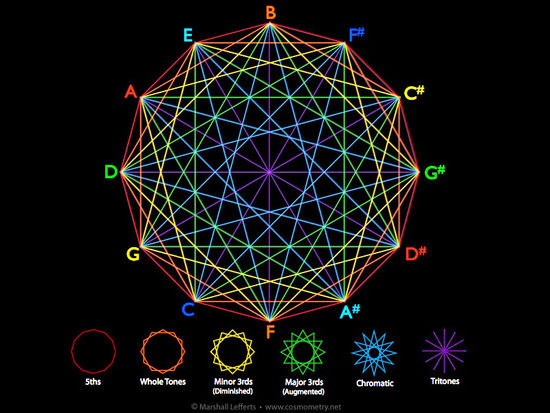
Full-size Image
~
a very engaging rendition of the Circle of Fifths:

http://www.cosmometry.net/basics-of-the-music-system
We will need to reference such a chart of the circle of fifths, in order to generate our Pythagorean system of pitches. Because, its not much fun if you just take for granted that I have correctly calculated Py's system. Our process will be one of learning.
All we need to know, are the basics.
First off, you may enjoy this video on the magic of 432Hz, as a warm up to our endeavor:
Now, we need to know the basics of harmonics which are very simple. The most fundamental rule of, at least, Western music is the octave: If you multiply the frequency of a note by 2, we arrive at the very same note at the next highest octave. So, on our guitar, we fret our string exactly 1/2 the length of the string, and we experience a higher pitch, a doubling of the same note. I know that this is simple stuff; I just want to develop the scenario up from the ground.
I want to inject a tiny excerpt from a wonderful book, Expanding Tonal Awareness, by Heiner Ruland, published, I might add, by the Rudolf Steiner Press (if there are any anthroposophists out there).
We can reflect on the fact that the ratio 2:1 lies behind every musical octave that ever sounds . . . Every scale is contained within the space of an octave; the space of an octave is sufficient for the presentation of every tone system, whether it be diatonic, chromatic, twelve-tone, or quarter-tone. All other tonal space is only a reflection of this one octave. It seems to us that the wonder of the octave is musically and philosophically inexhaustible so we do not intend to attempt to be exhaustive here. But perhaps one more thought might be mentioned: if a man and woman sing in "unison", then their voices are normally bound by the space of the creative octave, the interval which, like a microcosmos, can contain within itself or produce out of itself all of tonal space.
Next we will need the perfect fifth, a ratio of 3:2. This interval will be generated by a fundamental frequency, whatever we like, multiplied by 1.5, so that the resulting frequency is 150% of the fundamental. Whatever fundamental we choose, the result of our 1.5 multiplication results in the perfect fifth of the fundamental, and this interval is pure (i.e., 3:2 is the Definition of the perfect fifth), although this sort of *purity does not hold true for our "Equally Tempered" standard tuning system. (Honestly, I dunno why it is called the *Fifth--shows how little I know) . . In PD, we can create a number atom and split the output, first to an oscillator and second to a multiplier of 1.5 and then to a second oscillator. Voila, we have a sliding perfect fifth generator. It is that easy. And those are our Fundamentals that we needed all along.
To quote Heiner Ruland, yet again:
The octave (1:2) presents us with the repetition... or the mirroring, or the rediscovery... of the same tone at a higher level. But the ascending fifth gives us something else to contemplate: it opens a door which allows us to move away from ourself. The reverse happens with the descending fifth: it is a coming to oneself, it closes the door . . . What is true of the descending fifth is also essentially valid for the ascending pure fourth, for the modulation from minuet to trio can equally well be seen as descending by a pure fourth (c down to g), and from the trio back to minuet as ascending a pure fourth (g up to C). Thus, the pure fourth is an inversion of the fifth: descending, it opens out like the ascending fifth, moving away from itself; ascending, it closes like the descending fifth and comes to itself.
So to begin the hands-on mathematics (very simple algebra) portion of our learning adventure, let's start with a fundamental frequency that fits well into Pythagoras' tonal system, that is, a frequency produced by powers of 2 and of 3, such as 288Hz (2 to the power of 5 x 3 squared), which is a 'D' relative to the standard D of 293.67Hz, or 432Hz (2 to the fourth x 3 cubed), which is an 'A' relative to the standard pitch, 440Hz. Consider viewing the video above for more background info as to why we are choosing these numbers. Honestly, I have not entirely unlocked the mystery as to why these specific numbers work so well, except that these multiples of 3 and 2 capture our interval of the perfect fifth (3/2). If we make a chart with powers of 2 along one axis and powers of 3 along the other axis and list their cross products, we will discover something very useful to our endeavor.
Given our fundamental (we're going to use D, tuned to 288Hz for this example), let us begin generating all the other notes in our primary octave, and then we will want to expand our tuning system out into the octaves beyond, above and below. Given D, we want to complete the octave:
D (288), e, E, F, F#, G, G#, A, b, B, C, C#, D (576)
We need to reference the circle of fifths to see their ascending (and cyclic) arrangement, which is not entirely obvious to those of us who are not studied in music theory. They are ordered like so:
e, b, F, C, G, D, A, E, B, F#, C#, G#, e, ..
So, E is the perfect fifth of A. B is the perfect fifth of E, etc. The lower case letters are flats; we could just as easily have called e flat, D# (sharp) and b flat, A# (sharp). Of course, you already know this.
So we see, one perfect fifth up from our fundamental D, and we have A. And so we will multiply the frequency of D by 1.5 to determine the freqency of A.
D = 288
A = 288(3/2) = 432
..
D (288), e, E, F, F#, G, G#, A (432), b, B, C, C#, D (576)
How easy is that?
Next, solve for E, the perfect fifth of A.
A = 432
E = 432(3/2) = 648
It's so simple. The only thing is: this E lies outside of our primary octave, 288 to 576, so we will use the octave as our identity principal and divide E by 2, giving us: 324. So, now, we know:
D (288), e, E (324), F, F#, G, G#, A (432), b, B, C, C#, D (576) . . E (648)
E = 324
B = 324(3/2) = 486
D (288), e, E (324), F, F#, G, G#, A (432), b, B (486), C, C#, D (576) . . E (648)
...
I rest my case.
Peace easy, & Goodnight






